

Seiko: quality watchmaking and culture shock
By David Chokron
After a 5-day introductory workshop visit, Seiko recently revealed some of its secrets. Workshop manufacture, watchmaking craftsmanship, finishes, external parts, culture and work habits... what follows is the account of an extraordinary discovery: mechanical watchmaking Japanese style.
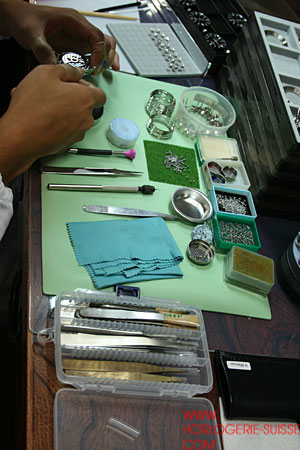 It is viewed with mistrust, perhaps even disdain tinged with nationalism. Unlike the Swiss industry, comprising myriad types of contributor, Japanese watchmaking is virtually embodied by a single company: Seiko. During a workshop visit lasting several days, the company recently revealed its many and varied facets. From the quartz watch costing 200 CHF.- to the minute repeater, of which only five models are made every year, the group offers a plethora of products, manufactured according to very different approaches and co-existing under a single umbrella.
It is viewed with mistrust, perhaps even disdain tinged with nationalism. Unlike the Swiss industry, comprising myriad types of contributor, Japanese watchmaking is virtually embodied by a single company: Seiko. During a workshop visit lasting several days, the company recently revealed its many and varied facets. From the quartz watch costing 200 CHF.- to the minute repeater, of which only five models are made every year, the group offers a plethora of products, manufactured according to very different approaches and co-existing under a single umbrella.
This diversity is the result of Seiko’s history. Inventor of the very first quartz wristwatch, the 1968 Astron, the brand continues to personify the power of the technological revolution at the time that was the miniature piezoelectric regulator.
The pioneer of the electronic watch and the digital watch, Seiko continues to produce movements in their millions. Manufactured by fully-automated production lines, they are still a source of pride for the group. Quartz is still a product of the future at Seiko, unlike in Switzerland. The group built its prosperity on this technology, which is one of the latest to be developed further. The 2012 Astron model is therefore quartz-powered, solar-recharged and features time-adjustment by satellite. Its antenna picks up the GPS signal from space and synchronises automatically.
Brand, group, country
Such a variety of approaches is also testament to the fact that Seiko is not just a simple brand, but a group. In Japan, it is composed of 12 brands, including just a handful who are marketed elsewhere, largely in Asia. The name on which the group relies for its mechanical watchmaking output is Grand Seiko. Although it is a fully-fledged institution in Japan, representing an old brand, still relatively unknown outside a circle of enthusiasts, it embodies the whole of Japan’s watchmaking expertise.
Created in 1960, it has supplied the country with high-quality mechanical watches for decades. It attempted to rival Switzerland with all its might, relying on the same techniques that had built the country’s industrial strength: imitating, learning, improving, capturing the market. Having jostled for position with the Swiss in the chronometry market throughout most of the 60s, Seiko finally won through with its quartz technology breakthrough. However, the company never abandoned its expertise in the field of mechanical watches and it is now the task of Grand Seiko to perpetuate these skills. In order to achieve this, two industrial sites supply it with the components and movements needed to produce the watches.
Mechanical watchmaking
Seiko Instruments Inc. is located in Morioka, in the north of the country. This is where the high-end Seiko mechanical movements are produced. On the one hand, thousands of square metres are devoted to the production of quartz movements in their millions. On the other, mechanical watchmaking represents just a drop of water in the industrial ocean. A dry stamping and profile-turning workshop is located just a few metres away from a burnishing workshop.
The next door conceals a decorating and straightening workshop. Everywhere you look, there are ten times as many machines as men. The industrial park is immense, and so is the floor area it occupies. The explanation is simple: each machine carries out one task. It is not reprogrammed, it is never left to cool down, it is always properly adjusted and therefore efficient. The thought of the underlying investment makes your head spin, as does the sheer scale of the production capacity.
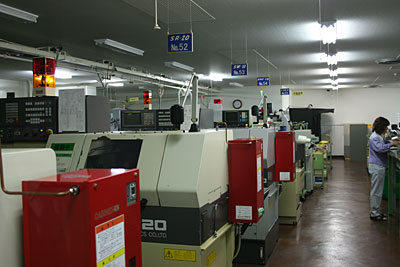

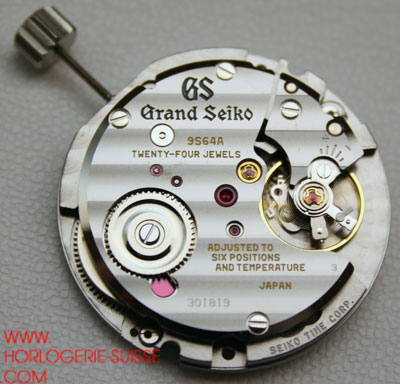 The workshop
The workshop
Having passed through an air lock of differential pressure, which draws out the dust, you enter T1: the Shizuku-Ishi Watch Studio. On the right, mounting and oiling are performed entirely by hand. On the left, taking photos is prohibited. A custom-made machine, coupled with two old OmegaMetrics, churn out balance springs. The Holy Grail of watchmaking is made here automatically, with minimal human intervention. The alloy is homemade and is called SPRON 610. The escapement wheels are made of nickel and shaped by MEMS, a LIGA-type precision electro-lithography system.
Seiko produces low-cost sets, which enable it to adjust the watches in the Grand Seiko range to -3 + 5 seconds a day without difficulty. This is where the balance springs are mounted on the balances, and then balanced and adjusted, all by hand. They are then incorporated into the 9R range of mechanical calibres. It is a small range and can be seen on the website at www.seiko.fr. Its watchwords are: automatic, efficient and few complications.
The workshop has an assembly capacity of 10,000 watches a year, far less than the apparent capacity of the machinery rooms that supply it. However, the processes are all manual, with little automation, or machine-assisted. The mounting and oiling, for example, are carried out by operators with medium-level qualifications, but manually.
Atmosphere
The work environment is like everywhere else, similar to Switzerland, but, in effect, totally different. The benches are made to measure for the operators (and not just height-adjustable) in Kaïki, an elm variety with veined red wood. The wooden structures are decorated with openwork metal corners. The chairs are ergonomically designed by Herman Miller, leaders in this material. Everyone works under a magnifying glass. There are no microscopes here, precision comes before comfort. The environment is climatically controlled and the crackdown on dust starts the moment workers enter the building, for here in Japan, everyone is required to remove their shoes and don slippers that would be worthy of an East German retirement home. Workers must then slip on a disposable hat, even more inelegant than the baker’s hat that watchmakers are wont to wear all the time. Their fingertips are the colour of latex and some wear cotton gloves on top (to prevent the skin from wrinkling). When the flange starts to cut off the circulation... they are simply told to take it off and use another finger.
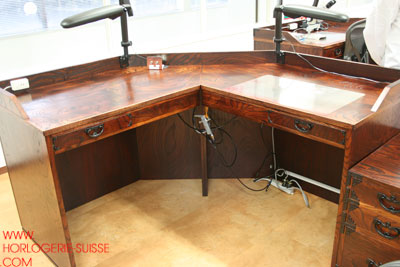

Work habits
A working day begins at 8.15 a.m. sharp and ends just as sharply at 5 p.m.. Three times a day, gentle background music fills the workshops. Everyone stops working and indulges for a few minutes in mandatory physical exercise for a healthy mind and body. The staff is mixed, of all ages and, despite the large number of inquisitive visitors, heavily focused on their work to avoid being asked any questions. The machinery is 90% Japanese, but the work tools can also be Swiss, Bergeon being an unavoidable maker’s name wherever you look. The rest of the mechanical movements are made in Singapore. They use a sub-brand no longer sold in Europe, called Seiko 5, which is very affordable and popular with simple watchmaking enthusiasts. We are assured that no components used in the mechanical watches are made or assembled in China.
The hybrid motor
The other mainstay of the Grand Seiko offering is called Spring Drive. This electromechanical hybrid system is based on the combination of a quartz regulator and a mechanical gear train. The transmission between the two is driven by a wheel whose speed is regulated electromagnetically, and whose rotation is transmitted directly to the seconds hand. Running smoothly and backlash-free, it is supposed to reflect the nature of passing time: constant and fluid. Spring Drive is another world all together. It adjusts with a precision of + or – 1 second per day, against the required -3 +5 for mechanical watches. All the Spring Drive movements are assembled in Shiojiri, near Nagano, in the middle of the country. This region specialises in precision mechanics in the way that some of the Swiss valleys specialise in profile-turning.
The plant belongs to Seiko Epson, the heart of a diversified industrial empire, where the highly specialised high-end watchmaking microworld joins the vast ocean that is Epson computing. It is divided into three parts. The Takumi studio assembles and cases up the Spring Drive calibres. The assembly processes are less precision-based but great care is nonetheless taken. The movement kits are delivered in bulk, the non-visible parts come into contact with one another and are scratched. The visible ones are treated with greater care. The keyword is pragmatism, and that pragmatism is primarily what led to the (long and arduous) conception of Spring Drive. The high-precision quartz calibre 9F is also made here, proudly valued for its recoilless micromotor, gear adjustment system and date change clocked at 1/2000th of a second.

Ligne d'assemblage automatisée des mouvements quartz
Striking mechanism room
The second studio is dedicated to little-exported jewellery pieces. The third is the microscopic workshop. You go down a staircase and open a little door to get into the striking mechanism workshop. In 2006, under the high-end brand Credor, Seiko showcased its striking-work, whose chime is sounded by a brass bowl-shaped gong. Based on the bell used by the Buddhist monks, the Orin bell is a true gem with an extraordinarily precise, pure, lingering sound. In 2012, the brand struck again with a decimal Minute Repeater (which sounds out the hours, ten-minute intervals and individual minutes), driven by a perfectly silent Spring Drive. Three craftsmen work full-time in this tiny broom cupboard under the eaves. This almost suffocating workspace creates a tightly bonded team, in splendid isolation, master craftsmen of time in a hyper-productive environment. Here is a recording of the repeater striking, produced at an average level of silence, but using state-of-the-art equipment.
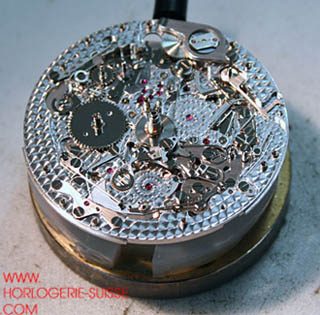

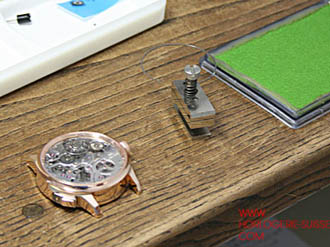
L'atelier des répétitions minutes avec à gauche une pièce en montage et à droite l'accordage d'un timbre
External parts
This workshop is also where the Grand Seiko cases, dials and hands are made. The aesthetics of the brand are relatively standardized and the range is kept small. The variety of operations is therefore limited. Just one shape of hands, with two diamond polishing variants, the dials predominantly grey sunburst, a transfer system using classic ink stamps... you could almost be in Switzerland. But the case polishing operation is totally unique and performed according to very strict procedures and guidelines. Roughing by the naked eye is tolerated for basic watches. High-end models and gold cases are held for polishing by arms that resemble those of diamond cutters. They are placed on rails that guide them along and polish off angles to the nearest degree. The painstaking care taken in this procedure makes the Geneva Seal look like the work of an amateur. They then undergo the Zaratsu process, a type of polishing that produces a special shine on the case. Once again, the number of men/machines is astonishing.
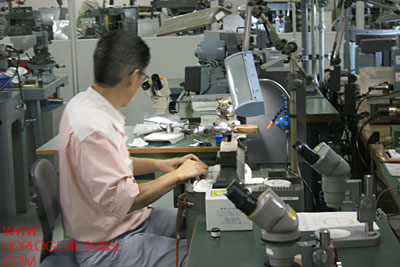
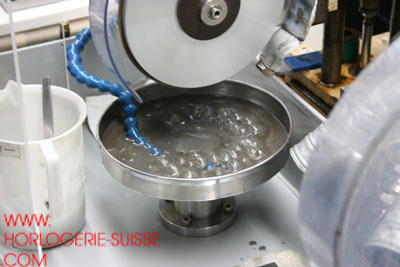
Atelier de décoration à Morioka et l'opération de soleillage des cadrans
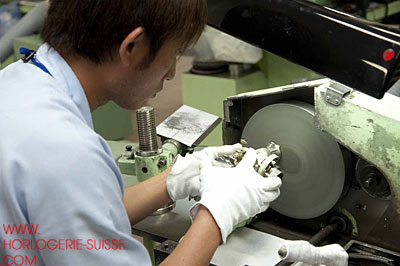
Polissage sur rail
A world of its own
Japanese watchmaking is worlds apart from its Swiss counterpart. It has borrowed its construction principles, methods and goals. At a time when mechanical watches are rediscovering the power of their own appeal, Grand Seiko is making a comeback to the international stage. Cautiously, the brand is seeking its share of the cake. In order to do this, it is proposing products that are exemplary for their simplicity. The fact that people find it hard to understand the principle behind Spring Drive, the fact that its brands are still perceived as bottom-of-the-range is no problem. The way ahead for the powers-that-be at Seiko is slow and methodical. The return of the complication will be a way of opening up to the needs of an international public that should help them to progress, the management being still driven by the Japanese market. Although the mechanisms are manufactured very much by hand, pragmatically and in large numbers, the genuine care taken in the external parts makes them a notch above the rest. It contributes in part to what gives Grand Seiko watches their truly excellent value for money.
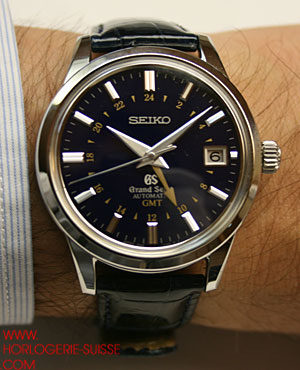
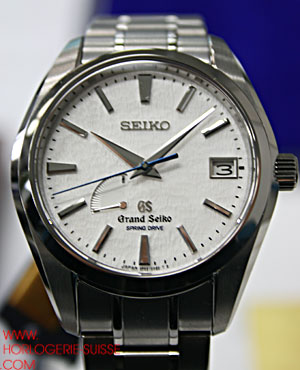
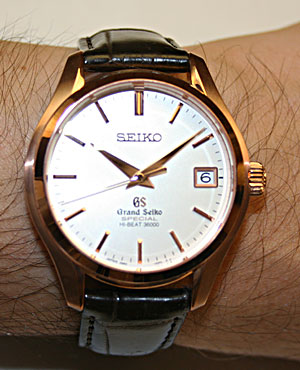
©
toute reproduction strictement interdite
Tweet
Article en français
On the forum (in french)